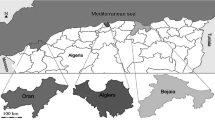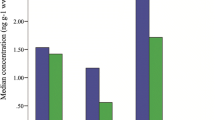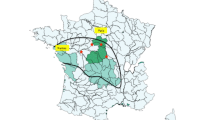Abstract
Isomer-specific concentrations of polychlorinated biphenyls (PCBs) including planar, mono- and di-ortho congeners and concentrations of DDT were determined in striped dolphins affected by a morbillivirus epizootic in the western Mediterranean in 1990. Extremely high concentrations of PCBs ranging from 94 to 670 μg/g (wet wt) were detected in the blubber. Similarly, DDT concentrations were high, between 22 and 230 μg/g (wet wt). The concentrations of three non-ortho coplanar PCBs were 43 (3,3′,4,4′-T4CB), 6.8 (3,3′,4,4′,5-P5CB), and 7.8 (3,3′,4,4′,5,5′-H6CB) ng/g (wet wt), respectively, the highest residue levels reported to date. The estimated 2,3,7,8-TCDD toxic equivalents of non-, mono- and di-ortho PCB congeners in striped dolphins were several times higher than those observed for other marine mammals and humans. Mono-ortho congeners contributed greater 2,3,7,8-TCDD toxic equivalents than non-ortho members. The higher ratio of 3,3′,4,4′,5,5′-H6CB/3,3′,4,4′,5-P5CB (IUPAC 169/126) suggested a strong induction of mixed function oxidase enzymes and highlighted the possibility of using this ratio as an index for risk assessment of PCB contamination in marine mammals. Elevated concentrations of PCBs may have played a role in the immune depression in striped dolphins, ultimately leading to the development of morbillivirus disease.
Similar content being viewed by others
References
Aguilar A, Raga JA (1993) The striped dolphin epizootic in the Mediterranean Sea. Ambio (in press)
Aulerich RJ, Bursian SJ, Breslin WJ, Olsson BA, Ringer RK (1985) Toxicological manifestation of 2,4,5,2′,4′,5′-, 2,3,6,2′,3′,6′- and 3,4,5,3′,4′,5′-hexachlorobiphenyls and Aroclor® 1254 in mink. J Toxicol Environ Hlth 15:63–79
Borrell A, Aguilar A (1987) Variations in DDE percentage correlated with total DDT burden in the blubber of fin and sei whales. Mar Pollut Bull 18:70–74
—, — (1992) Pollution by PCBs in striped dolphins affected by the western Mediterranean epizootic. In: Pastor X, Simmonds M (eds) Proceedings of the Mediterranean Striped Dolphin Mortality International Workshop. Green Peace International Mediterranean Sea Project, Madrid, Spain, pp 121–127
Brody M (1989) Explaining sea mammal deaths proves challenging. Am Soc Microbiol News 56:595–598
Brouwer A, Reijnders PJH, Koeman JH (1989) Polychlorinated biphenyl (PCB)-contaminated fish induces vitamin A and thyroid hormone deficiency in the common seal (Phoca vitulina). Aquat Toxicol 15:99–106.
Cummins JE (1988) Extinction: The PCB threat to marine mammals. Ecologist 18:193–195
Daelemans FF, Mehlum F, Schepens PJC (1992) Polychlorinated biphenyls in two species of Arctic seabirds from the Svalbard area. Bull Environ Contam Toxicol 48:828–834
Fossi MC, Marsili L, Leonzio C, Sciara GND, Zanardelli M, Focardi S (1992) The use of non-destructive biomarker in Mediterranean cetaceans: Preliminary data on MFO activity in skin biopsy. Mar Pollut Bull 24:459–461
Fowler SW (1990) Critical review of selected heavy metal and chlorinated hydrocarbon concentrations in the marine environment. Mar Environ Res 29:1–64
Harwood J, Reijnders PJH (1988) Seals, sense and sensibility. New Sci 120:28–29
Helle E, Olsson M, Jensen S (1976) DDT and PCB levels and reproduction in ringed seal from the Bothnian Bay. Ambio 5:188–189
Kannan N, Tanabe S, Wakimoto T, Tatsukawa R (1987) Coplanar polychlorinated biphenyls in Aroclor and Kanechlor mixtures. J Assoc Offic Anal Chem 70:451–454
Kannan N, Tanabe S, Okamoto T, Tatsukawa R, Phillips DJH (1989a) Polychlorinated biphenyls (PCBs) in sediments in Hong Kong: A congener-specific approach to the study of coplanar PCBs in aquatic ecosystems. Environ Pollut 62:223–235
Kannan N, Tanabe S, Ono M, Tatsukawa R (1989b) Critical evaluation of polychlorinated biphenyl toxicity in terrestrial and marine mammals: Increasing impact of non-ortho and mono-ortho coplanar polychlorinated biphenyls from land to ocean. Arch Environ Contam Toxicol 18:850–857
Kashimoto T, Miyata H, Takayama K, Ogaki J (1987) Levels of PCDDs, coplanar PCBs and PCDFs in patients with Yusho and the causal oil by HR-GC, HR-MS. Fukuoka Acta Med 78:325–336 (in Japanese)
Kubiak TJ, Harris HJ, Smith LM, Schwartz TR, Stalling DL, Trick JA, Sileo L, Docherty DE, Erdman TC (1989) Microcontaminants and reproductive impairment of the Forster's tern on Green Bay, Lake Michigan—1983. Arch Environ Contam Toxicol 18:706–727
Kuehl DW, Haebler R, Potter C (1991) Chemical residues in dolphins from the U.S. Atlantic coast including Atlantic bottlenose obtained during the 1987/88 mass mortality. Chemosphere 22:1017–1084
Law RL, Allchin CR, Harwood J (1989) Concentrations of organochlorine compounds in the blubber of seals from eastern and northeastern England, 1988. Mar Pollut Bull 20:110–115
Lockyer CH, Smellie CG, Goodall RNP, Cameron IS (1981) Examination of teeth of Commerson's dolphin, Cephalorhynchus commersonii, for age determination. J Zool (London) 195:123–131
Loose LD, Pitman KA, Bentitz KF, Silkworth JB (1977) Polychlorinated biphenyl and hexachlorobenzene induced humoral immunosuppression. J Reticuloendo Soc 22:253–271
Myrick AC, Hohn AA, Sloan PA, Kimura M, Stanley DD (1983) Estimating age of spotted and spinner dolphins (Stenella attenuata and Stenella longirostris) from teeth. NOAA Tech. Memo. NMFS, NMFS-SWFC-30, p 17
Poland A, Knutson JC (1982) 2,3,7,8-tetrachlorodibenzo-p-dioxin and related halogenated aromatic hydrocarbons: Examination of the mechanism of toxicity. Ann Rev Pharmacol Toxicol 22:517–554
Reijnders PJH (1986) Reproductive failure in common seals feeding on fish from polluted waters. Nature 324:456–457
Safe S (1990) Polychlorinated biphenyls (PCBs), dibenzo-p-dioxins (PCDDs), dibenzofurans (PCDFs), and related compounds: Environmental and mechanistic considerations which support the development of toxic equivalency factors (TEFs). Crit Rev Toxicol 21:51–88
Simmonds M (1991) What future for European seals now the epidemic is over? Oryx 25:1–6
Simmonds M, Johnston PA (1989) Seals, sense and science. Mar Pollut Bull 20:580–583
Tanabe S, Kannan N, Wakimoto T, Tatsukawa R (1987a) Method for the determination of three toxic non-ortho chlorine substituted coplanar PCBs in environmental samples at part-per-trillion levels. Int J Environ Anal Chem 29:199–213
Tanabe S, Kannan N, Subramanian AN, Watanabe S, Tatsukawa R (1987b) Highly toxic coplanar PCBs: Occurrence, source, persistency and toxic implications to wildlife and humans. Environ Pollut 47:147–163
Tanabe S, Tatsukawa R, Phillips DJH (1987) Mussels as bioindicators of PCB pollution: A case study on uptake and release of PCB isomers and congeners in green lipped mussels (Perna viridis) in Hong Kong waters. Environ Pollut 47:41–62
Tanabe S (1988) PCB problems in the future: Foresight from current knowledge. Environ Pollut 50:5–28
Tanabe S, Watanabe S, Kan H, Tatsukawa R (1988) Capacity and mode of PCB metabolism in small cetaceans. Mar Mamm Sci 4:103–124
Tanabe S, Tatsukawa R (1991) Persistent organochlorines in marine mammals. In: Jones KC (ed) Organic Contaminants in the environment—environmental pathways and effects. Elsevier Applied Science Publishers Ltd, New York, pp 275–289
Thomas PT, Hinsdill RD (1978) Effect of polychlorinated biphenyls on the immune responses of Rhesus monkeys and mice. Toxicol Appl Pharmacol 44:41–51
Voogt PD, Wells DE, Reuterg»rdh L, Brinkman UATH (1990) Biological activity, determination and occurrence of planar, mono- and di-ortho PCBs. Int J Environ Anal Chem 40:1–46
Vos JG, Luster MI (1989) Immune alterations. In: Kimbrough RD, Jensen AA (eds), Halogenated biphenyls, terphenyls, naphthalenes, dibenzodioxins and related products. Elsevier Publishers, Amsterdam, pp 295–322
Wagemann R, Muir DCG (1984) Concentrations of heavy metals and organochlorines in marine mammals of northern waters: Overview and evaluation. Canadian Technical Report of Fisheries and Aquatic Sciences No. 1279, Western Region, Department of Fisheries and Oceans, Canada
Wakimoto T, Tatsukawa R, Ogawa T (1971) Analytical methods of PCBs. J Environ Pollut Control 7:517–522 (in Japanese)
Watanabe S, Shimada T, Nakamura S, Nishiyama N, Yamashita N, Tanabe S, Tatsukawa R (1989) Specific profile of liver microsomal cytochrome P-450 in dolphin and whales. Mar Environ Res 27:51–65
Yamashita N, Tanabe S, Ludwig JP, Kurita H, Ludwig ME, Tatsukawa R (1993) Embryonic abnormalities and organochlorine contamination in double-crested cormorants (Phalacrocorax auritus) and Caspian terns (Hydroprogne caspia) from the upper Great Lakes in 1988. Environ Pollut 79:163–173
Yoshimura H, Yoshihara S, Koga N, Nagata K, Wada I, Kuroki J, Hokama Y (1985) Inductive effect on hepatic enzymes and toxicity of congeners of PCBs and PCDFs. Environ Hlth Perspect 59:113–119
Author information
Authors and Affiliations
Rights and permissions
About this article
Cite this article
Kannan, K., Tanabe, S., Borrell, A. et al. Isomer-specific analysis and toxic evaluation of polychlorinated biphenyls in striped dolphins affected by an epizootic in the western Mediterranean sea. Arch. Environ. Contam. Toxicol. 25, 227–233 (1993). https://doi.org/10.1007/BF00212134
Received:
Revised:
Issue Date:
DOI: https://doi.org/10.1007/BF00212134




